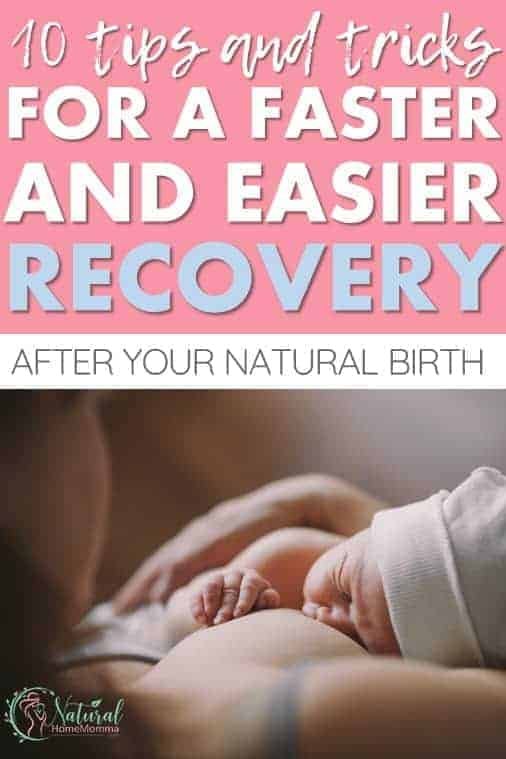
After you complete the miracle (and often marathon) of your home birth, there is some recovery involved. The first few days postpartum can be pretty uncomfortable down there, and it usually isn’t until 6 weeks (or more!) after your baby’s birth that you will be feeling mostly back to normal.
The thing about postpartum recovery is that it’s happening while you are adjusting to life with a newborn, starting your breastfeeding relationship, and existing on (likely) a lot less sleep. Luckily, by learning about the postpartum recovery ahead of time, and following these tips, you can help your postpartum recovery be a little bit faster and easier.
What can you do for a faster and more comfortable postpartum recovery?
Make sure you are stocked up on postpartum care supplies, understand your postpartum care plan, rest as much as possible, and take your recovery seriously while adjusting to life with a newborn.
10 Tips to feel more comfortable and heal faster after your home birth
1. Have postpartum care supplies ready to go
If you are reading this article before giving birth, you can give yourself a huge advantage during your postpartum recovery by having care supplies on hand. You’ll be so glad to gather these items along with the rest of your home birth checklist so you can get comfortable right away. If not, don’t fret! Your partner or loved one can easily head out with a list of necessities in tow 😉
Immediately after birth, you will need to use large, absorbent pads to control your postpartum bleeding. Postpartum bleeding, known as lochia, starts off very heavy and begins to lessen in the 3-10 days after birth. (source)
What will keep me the most comfortable?
To maximize healing and promote comfort, try to change your pads as often as possible. Keeping yourself dry and clean will keep harmful bacteria at bay. After birth, your midwife will teach you how to clean yourself using a peri bottle and set up a large pad with witch hazel pads to help with swelling and discomfort.
Additionally, you can use ‘padsicles’ to ease uncomfortable hemorrhoids and discomforts associated with tears you may experience. This is essentially a pad that has been soaked in liquid and frozen to use as an ice pack. Plain water will suffice, but some women like to add aloe and/or lavender. Here is a great recipe for DIY padsicles.
Some women benefit from sitting on a donut cushion to keep pressure off of their sore bottom, others creatively use their pregnancy pillows to do the job.
2. Take care of your perineum and hemorrhoids to help them heal
You will experience a lot of swelling and discomfort down there after your home birth. Your perineum will have stretched, you’ll likely have hemorrhoids, and you may experience tearing. Your home birth midwife will be equipped to suture up your tears if necessary.
Luckily, there are a number of ways you can help your perineum heal faster and keep yourself more comfortable after birth:
Sitz Baths
Sitz baths feel absolutely amazing on your sore perineum and hemorrhoids after natural birth. A sitz bath is a bath with only a few inches of water. You can use your own bathtub for this, or invest in a portable sitz bath that will fit into your toilet. The advantage to a portable one is that you don’t have to squat or get into and out of the tub which may be uncomfortable.
You fill the bath with warm water, and often, add herbs, Epsom salt, vinegar or essential oils. You then let your sore area soak for 10-20 minutes.
Herbal Sprays
Because it may not be realistic to regularly do soothing sitz baths while caring for a newborn, I highly recommend an herbal spray. My favorite was the Motherlove Sitz Bath Spray, and I’ve also heard good things about the Earth Mama Herbal Perineal Spray.
Witch Hazel
Nothing feels quite as good on your swollen, sore perineum and hemorrhoids as witch hazel. Be sure to stock up on pre-soaked witch hazel pads. You can use these to line your pad after using the bathroom for lasting relief.
Ice Packs/Padsicles
I already mentioned the wonders of padsicles above, but wanted to reiterate their use here. Padsicles, along with perineal cool packs, can be used a few times a day for around 10 minutes. Icing your sore and swollen body will help you heal faster and keep you more comfortable.
3. Make your postpartum bowel movements more manageable
As you can imagine, your first few bowel movements after birth can be pretty painful thanks to all the swelling and other discomforts going on. You can help make this more manageable by using a stool softener, eating foods that will naturally help you go (hello pears!) and drinking lots (and lots!) of water.
It is also helpful to raise your feet using a step-stool or Squatty Potty when you feel like you need to go. Your position during a bowel movement can make the whole experience a whole lot ahem smoother.
If you are having issues with constipation in the first few days after your home birth, do not wait to let your midwife know. She will be able to suggest more specific ideas or prescribe something that can help. Straining to use the bathroom can further aggravate swelling and hemorrhoids you developed after birth.
4. Rest, rest, rest as much as your new baby will allow
No matter how your home birth unfolds, there’s no way around the fact that your body did endure some level of trauma. While the prize of a newborn can’t be beat, your body needs time to recover from such an event. In the first few days to weeks following birth you should be resting in bed and breastfeeding baby. That’s about it.
Enlist the help of your partner and trusted loved ones to pick up the rest of the slack. Hopefully others can handle household tasks, childcare of siblings, and even diaper changes in at least the first few days. The more you can rest the better your body can heal.
5. Make breastfeeding more comfortable, too
Part of the postpartum recovery after a home birth does involve the transition into breastfeeding. Breastfeeding often leaves momma with cracked and sore nipples. You might also feel discomfort, tenderness, and engorgement when your milk comes in.
There are some things you can have on hand to help with these discomforts. A good quality nipple cream will go a long way in helping your cracked and sore nipples. As for tenderness and engorgement, the best thing you can do is wear a nursing bra all the time. They make super comfy night nursing bras that are perfect for lounging around but still providing support.
6. Ease into movement and listen to your body
When you feel up for it, moving around the house is a good idea. Moving your body, even in small amounts, will help keep your bowel movements regular and loosen up your sore muscles. After a week or two you may feel up for short and very slow walks around the yard or block.
What’s most important to remember is to increase your movement and walks slowly. Remember that your heaviest postpartum bleeding will occur in the 3-10 days after birth. After this, your bleeding should be tapering each day and the blood will begin to look brown or pink.
If you suddenly see bright red blood or an increase in bleeding, that’s a big sign that you are overdoing it, and it is time to scale back.
7. Continue taking your vitamins
Continuing to take your prenatal vitamin after birth will help keep your body full of the nutrients it needs to heal and produce high-quality breastmilk. According to the American Pregnancy Association, medical professionals recommend a vitamin be taken throughout breastfeeding.
However, they recommend switching to a vitamin that more specifically addresses the unique nutritional needs of lactating women. Specifically, they mention this nursing postnatal vitamin.
8. Know the difference between the baby blues and postpartum depression
While most of this article has focused on the physical discomforts associated with postpartum healing after birth, it’s so important to check in on the psychological side of things too.
The “baby blues” are mood swings that 70-80% of all women experience after birth. They typically hit around 4-5 days postpartum and result in crying, irritability, anxiety, fatigue, insomnia, and general sadness.
Baby blues usually resolve in 2-3 weeks after birth. If you are feeling symptoms worsen, lasting beyond 2-3 weeks, or to a degree that is inhibiting your ability to function or care for your baby you may be experiencing postpartum depression.
It is very important to call your midwife if you have ANY concerns about postpartum depression or the baby blues. Mental health after birth is important and professional help can make all the difference.
Get your partner informed
If you are reading this before your home birth, educate your partner about the warning signs of the baby blues and postpartum depression. You may not be able to identify the symptoms in yourself when you are in it. If you partner knows what to look for, he can make sure you get the help you need.
9. Keep in touch with your midwife during your postpartum healing
After your home birth, your midwife will stick around until she sees that you are cleaned up, comfortable, have a good start on breastfeeding, and understand your postpartum care plan. Your postpartum care plan will involve how to care for yourself down there and red flags that would warrant a phone call.
In short, be sure to reach out to your midwife if you are having any doubts about your postpartum healing. There will be scheduled postpartum visits, but any concerns should be addressed quickly to avoid complications.
10. Limit visitors and keep visits short and low-stakes
I already mentioned how important rest is for a faster postpartum recovery. Nothing will inhibit this more than a revolving door of visitors. I highly recommend limiting visitors in the first few weeks after birth. When visitors do come, keep the visits short and don’t feel bad about sleeping or resting when they are there– especially if the baby is asleep!
Postpartum care kit checklist for after your home birth?
Here’s a quick checklist of things you’ll be so glad to have on hand, just for you, after your home birth:
- Maternity or overnight pads
- Adult diapers
- Witch hazel pads
- DIY padsicles
- Perineum cooling packs
- Peri bottle
- Sitz spray
- Sitz bath
- Stool softener
- Squatty
potty - Donut cushion (or pregnancy pillow repurposed)
- Nipple cream
- Night nursing bra
Remember, your postpartum recovery won’t last forever!
The tips and supplies recommended in this article will help you feel more comfortable and heal faster after birth. But it’s so important to remember that the birth and recovery is unique to each and every momma. The recovery won’t even be the same from one child to the next!
So give your body and your mind time to return to normal. Focus on the amazing feat your body accomplished over the last 9 months and respect that it probably won’t ‘bounce right back’. And that’s okay!
In the meantime, use the padsicles, okay 😉
And don’t stop your preparations here, momma! Be sure to check out our Home Birth section for more great advice on preparing every aspect of your home, family, and self for your home birth.


